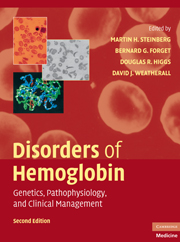Book contents
- Frontmatter
- Contents
- List of Contributors
- Foreword, by H. Franklin Bunn
- Preface
- Introduction, by David J. Weatherall
- SECTION ONE THE MOLECULAR, CELLULAR, AND GENETIC BASIS OF HEMOGLOBIN DISORDERS
- SECTION TWO PATHOPHYSIOLOGY OF HEMOGLOBIN AND ITS DISORDERS
- SECTION THREE α THALASSEMIA
- SECTION FOUR THE β THALASSEMIAS
- SECTION FIVE SICKLE CELL DISEASE
- SECTION SIX OTHER CLINICALLY IMPORTANT DISORDERS OF HEMOGLOBIN
- SECTION SEVEN SPECIAL TOPICS IN HEMOGLOBINOPATHIES
- SECTION EIGHT NEW APPROACHES TO THE TREATMENT OF HEMOGLOBINOPATHIES AND THALASSEMIA
- Index
- Plate section
SECTION FOUR - THE β THALASSEMIAS
Published online by Cambridge University Press: 03 May 2010
- Frontmatter
- Contents
- List of Contributors
- Foreword, by H. Franklin Bunn
- Preface
- Introduction, by David J. Weatherall
- SECTION ONE THE MOLECULAR, CELLULAR, AND GENETIC BASIS OF HEMOGLOBIN DISORDERS
- SECTION TWO PATHOPHYSIOLOGY OF HEMOGLOBIN AND ITS DISORDERS
- SECTION THREE α THALASSEMIA
- SECTION FOUR THE β THALASSEMIAS
- SECTION FIVE SICKLE CELL DISEASE
- SECTION SIX OTHER CLINICALLY IMPORTANT DISORDERS OF HEMOGLOBIN
- SECTION SEVEN SPECIAL TOPICS IN HEMOGLOBINOPATHIES
- SECTION EIGHT NEW APPROACHES TO THE TREATMENT OF HEMOGLOBINOPATHIES AND THALASSEMIA
- Index
- Plate section
Summary
Over the years, study of the thalassemia syndromes has served as a paradigm for gaining insights into the factors that can regulate or disrupt normal gene expression. The thalassemias constitute a heterogeneous group of naturally occurring, inherited mutations characterized by abnormal globin gene expression resulting in total absence or quantitative reduction of α- or β-globin chain synthesis in human erythroid cells. α Thalassemia is associated with absent or decreased production of α-chains, whereas in the β thalassemias, there is absent or decreased production of β-chains. In those cases in which some of the affected globin chain is synthesized, early studies demonstrated no evidence of an amino acid substitution. In all cases in which genetic evidence was available, the thalassemia gene appeared to be allelic with the structural gene encoding α- or β-globin. The elucidation of the nature of the various molecular lesions in thalassemia has been a fascinating process, and full of surprises. Increase in our knowledge of the molecular basis of β thalassemia has closely followed and depended on progress and technical breakthroughs in the fields of biochemistry and molecular biology. In particular, recombinant DNA and polymerase chain reaction–based technologies have contributed to a virtual explosion of new information on the precise molecular basis of most forms of thalassemia. The accrual of this knowledge has, to a great degree, paralleled the acquisition of new, detailed information on the structure, organization, and function of the normal human globin genes, as described in the preceding chapters.
- Type
- Chapter
- Information
- Disorders of HemoglobinGenetics, Pathophysiology, and Clinical Management, pp. 321 - 322Publisher: Cambridge University PressPrint publication year: 2009

